-
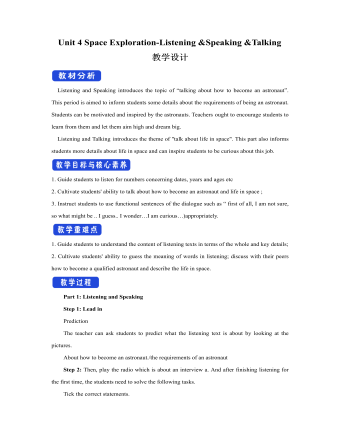
新人教版高中英语必修3Unit 4 Space Exploration-Listening&Speaking&Talking教学设计一
Listening and Speaking introduces the topic of “talking about how to become an astronaut”. This period is aimed to inform students some details about the requirements of being an astronaut. Students can be motivated and inspired by the astronauts. Teachers ought to encourage students to learn from them and let them aim high and dream big.Listening and Talking introduces the theme of "talk about life in space". This part also informs students more details about life in space and can inspire students to be curious about this job. 1. Guide students to listen for numbers concerning dates, years and ages etc2. Cultivate students' ability to talk about how to become an astronaut and life in space ; 3. Instruct students to use functional sentences of the dialogue such as “ first of all, I am not sure, so what might be .. I guess.. I wonder…I am curious…)appropriately.1. Guide students to understand the content of listening texts in terms of the whole and key details; 2. Cultivate students' ability to guess the meaning of words in listening; discuss with their peers how to become a qualified astronaut and describe the life in space.Part 1: Listening and SpeakingStep 1: Lead inPredictionThe teacher can ask students to predict what the listening text is about by looking at the pictures.About how to become an astronaut./the requirements of an astronautStep 2: Then, play the radio which is about an interview a. And after finishing listening for the first time, the students need to solve the following tasks.
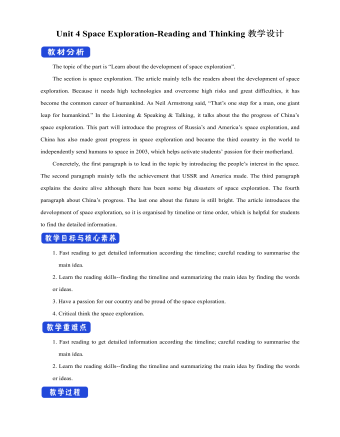
新人教版高中英语必修3Unit 4 Space Exploration-Reading and Thinking教学设计一
Q4: What is the function of the International exploration ?Having astronauts from different countries on boardQ5: What can you learn from Para 4 ?China has made great achievements in exploring spaceQ6: What is the attitude to the space exploration ?SupportiveStep 6 Post reading---RetellPeople have always wanted to learn more about space. Before the mid-20th century, most people felt (1)_________ (travel) into space was an impossible dream. However, (2)____ the help of scientists, peoplesucceeded in realizing their dream (3) _________ (explore) space. On 4 October 1957, the Sputnik 1 satellite (4) ____________(launch) by the USSR. (5) ________________ scientists try to make sure nothing goes wrong, accidents can still happen. These disasters made everyone(6)___________(disappoint), but people still believe in the importance of (7) ________(carry) on space exploration. In 2003, China became the third country to (8)_____________ (independent) send humans into space. Then Shenzhou 6 and 7 completed (9)____ second manned orbit and the first Chinese spacewalk. In spite of the difficulties, scientists hope future (10)__________ (discovery) will not only enable us to understand the universe but also help us survive well into the future.Answers: 1. travelling 2. with 3. to explore 4. was launched 5. Although6. disappointed 7. carrying 8. independently 9. a 10. discoveriesStep 6 Post reading---Critical thinkingQ1: What do you think of the space exploration ? I think it is beneficial to us. Through further study of space, people will make full use of it in the future, such as the space experiments by Wang Yaping in Tian Gong 1.Q2: If you are determined to be an astronaut, what should you prepare at present ?First of all, I should study hard to get a related college degree. Besides, I must keep mental and physical healthy.Step 7. HomeworkTry to summarize the structure of the article by a mind map.
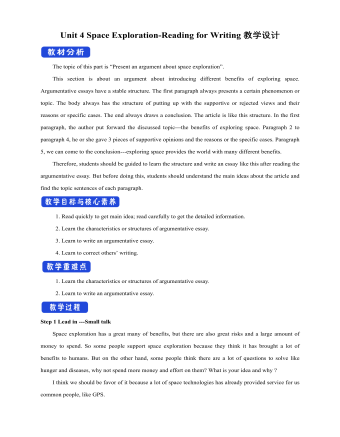
新人教版高中英语必修3Unit 4 Space Exploration-Reading for Writing教学设计二
⑦在我看来, 探索太空是值得的。As far as I am concerned, it is worthwhile to explore the space.Step 10 Writing---draftRecently, students in our class have had heated a discussion on whether space is worth exploring. Students hold different ideas about it.30% of us think space exploration is not worthwhile. They think space is too far away from us and our daily life and is a waste of money. And the money spent on space exploration can be used to solve the earth’s problems such as starvation and pollution.On the other hand,70% think space is worth exploring because we have benefited a lot from it,such as using satellites for communication and weather forecast. What’s more,with further space research,we may solve the population problem by moving to other planets one day. Also,space research will enable us to find new sources to solve the problem of energy shortages on the earth.As far as I am concerned, it is worthwhile to explore the space. Not only can it promote the development of society but also enrich our life. Step 11 Pair workExchange drafts with a partner. Use this checklist to help your partner revise his/her draft.1.Does the writer explain why he/she changed/wanted to change?2.Does the writer tell how the changes have improved or will improve his/her life?3.Is the text well-organised?4.Does the writer use words and expressions to show similarities and differences?5.Are there any grammar or spelling errors?6.Does the writer use correct punctuation?
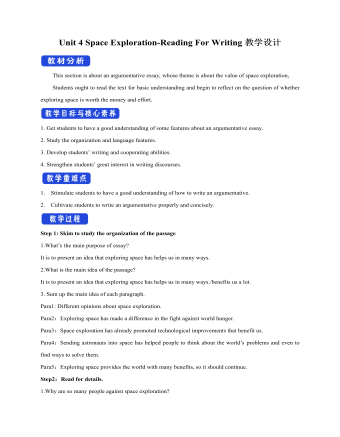
新人教版高中英语必修3Unit 4 Space Exploration-Reading For Writing教学设计一
另一方面,其余的人反对这个计划,因为它可能会导致一些不好的影响。7.I hold the belief that space exploration not only enable us to understand how the universe began but also help us survived well into the future.我坚信探索太空不仅能够使我们了解宇宙的起源而且能够帮助我们更好地走进未来。8.I think we should spend more time and money exploring space so as to provide new and better solutions to people's shortterm and longterm problems.为了给人类的短期和长期问题提供更新和更好的解决方法,我认为我们应该花更多的时间和金钱来探索太空。9.From my point of view,it is wrong of young people to depend on their telephones too much,which may do harm to both their physical and mental health.在我看来,年轻人过度依赖手机是不对的,因为它们可能会对他们的身心健康都有害。最近你班同学就“人类是否应该进行宇宙探索”这个问题进行了激烈的讨论。有人认为,探索宇宙不仅让人类更好地了解宇宙的发展,还可以用来指导农业生产,以及把一些探索太空的高新技术用于现实生活;也有一些人认为探索太空花掉了大量的人力物力;影响了人们的生活水平。请你根据以下情况写一篇报告并发表自己的观点。注意:1.写作内容应包括以上全部要点,可适当发挥,使上下文连贯;
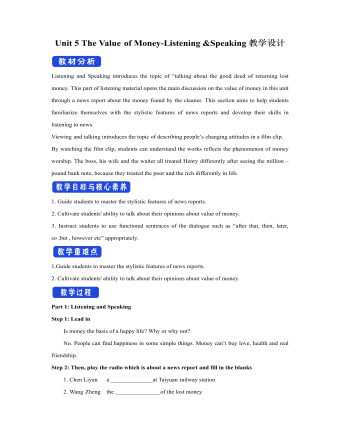
新人教版高中英语必修3Unit 5 The Value of Money-Listening &Speaking教学设计
Step 4: Listen again and decide if the following statements are true (T) or false (F).1 It was the first time Chen Liyan's story was reported. T口 F口2 Chen found 10,000 yuan in a small plastic bag in Taiyuan railway station口 F口3 Wang Zheng apologized to Chen because he couldn't offer her more money. T口 F口4 Chen took out a large loan to cure her daughter, T口 F口5 Wang set up a fundraising website for Chen's daughter after Chen told him about her situation. T口 F口Step 5:After listening, discuss the questions.1 What kind of person do you think Chen Liyan is?Chen Liyan is generous and honest because she returned a large sum of money to the owner.2 Did Chen return the money because she didn't need it?No. She returned the money because it was the right thing to do. Evidence for this is that she refused to accept the reward money because she felt that it had not been earned. 3 Is it common for people to do what Chen did?It depends on the culture. In some countries it is quite common to return money that has been found. In other countries, people believe "Finders are keepers!" 4 How did Wang Zheng feel about the return of his money?He must have been very happy and relieved to have gotten his money back. We know this because he thanked Chen repeatedly and even offered her a reward.5 Why did Ma Dongbao tell Wang about Chen's family?He must have had great sympathy for Chen and her daughter and wanted to help them.'We know this because he arranged help for them. 6 How did the news reporter feel about Chen's actions?The news reporter felt that it showed that money wasn't the most important thing in life. We know this because the reporter told us that this is what Chen believes. and then said, “that's a great attitude to take."
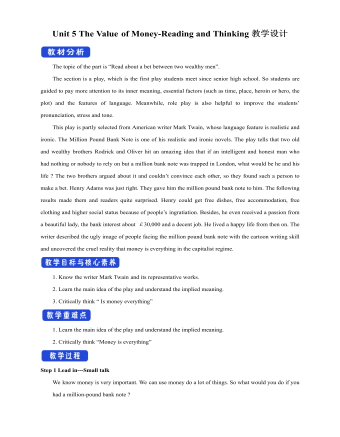
新人教版高中英语必修3Unit 5 The Value of Money-Reading and Thinking教学设计一
Everybody wants to get wealth.In today’s material world,making money or becoming wealthy symbolizes a person’s success and capability. Many people just make every effort, pay any price to attain greater wealth. With money,they can buy nice, large apartments in nice neighborhood. With money they can own luxurious cars. Wealth seems to bring all happiness in life.But is wealth the only road to happiness? Not really. There are many things in the world, which are beyond the means of money, such as friendship, love, health and knowledge. People are so preoccupied with struggling for money that they have no time or would not take the time to form or maintain friendship. What happiness can they feel living as lonely miserable creatures without love or friends in the world even if they accumulate tremendous wealth?In my opinion, people can’t do anything without money, but money is not everything. What money will bring you depends on your personal belief and goal in life. If you are kind enough to help others, especially the poor, money is a good thing to you. With it, you can do much more for the benefit of people and your country, and it will add to your own happiness. If you want money just for your own needs, you’ll never be satisfied or happy. In a word,you should have money spent for more people. Only then can money be the source of your happiness.Step 8 Homework4 students in a group, one acts Roderick, one Oliver, one servant and the fourth one acts Henry Adams, then listen to the tape, pay more attention to the difference between American English and British English in pronunciation, stress, tone.
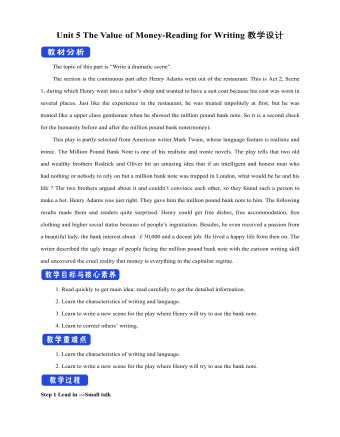
新人教版高中英语必修3Unit 5 The Value of Money-Reading for Writing教学设计二
2. 您能看到, 我头发太长了。You can see that my hair is much too long.3. 无论什么时候, 只要您想回来就回来。Please come back whenever you want.4. 您仅有很少的头发要理! You only have too little hair to cut !5. 为您服务是我的荣幸!It is my honour to serve you!Step 9 Writing(Henry is walking down the street when he sees a sign for a place that cuts hair. He decides to have it cut. )H=Henry B=BarberH: Good afternoon, I’d like to have my hair cut, if I may. (The barber looks at Henry’s hair and continues cutting another man’s hair. ) Er, I’d really like a haircut. As you can see it’s much too long. B: (in a rude manner) Yes, I can see that. Indeed, I can. H: Fine, well, I’ll have a seat then. (He sits in one of the barber’s chairs. The barber turns to look at Henry. )B: It’s quite expensive here, you know! Are you sure you can afford it?H: Yes. I think so. (After his hair is cut, the barber tells Henry how much he must pay. Henry shows the barber the bank note. )B: Why Mr. . . (looks shocked)H: Adams. Henry Adams. I’m sorry. I don’t have any change. B: Please don’t worry! (wearing a big smile) Nothing to worry about! Nothing at all! Please come back whenever you want, even if you only have too little hair to cut! It will be my honour to serve you!Step 10 Pair workExchange drafts with a partner. Use this checklist to help your partner revise his/her draft.1. Are all the elements of a play included and in good order ?2. Do the character use suitable language ?3. Are the stage directions clear and useful ?4. Is the plot clear and exciting enough ?
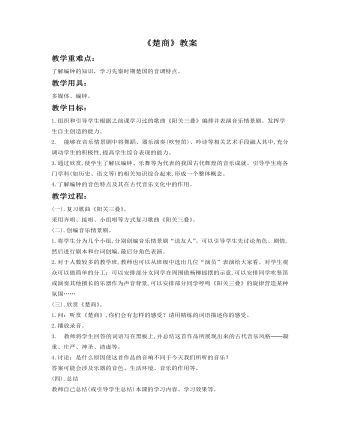
《楚商》教案
(一).复习歌曲《阳关三叠》。采用齐唱、接唱、小组唱等方式复习歌曲《阳关三叠》。(二).创编音乐情景剧。1.将学生分为几个小组,分别创编音乐情景剧“送友人”。可以引导学生先讨论角色、剧情,然后进行剧本和台词创编,最后分角色表演。2.对于人数较多的教学班,教师也可以从班级中选出几位“演员”表演给大家看。对学生观众可以做简单的分工:可以安排部分女同学在周围做杨柳摇摆的示意,可以安排同学吹竖笛或演奏其他擅长的乐器作为声音背景,可以安排部分同学哼鸣《阳关三叠》的旋律营造某种氛围……(三).欣赏《楚商》。1.问:听赏《楚商》,你们会有怎样的感受?请用精练的词语描述你的感受。2.播放录音。3. 教师将学生回答的词语写在黑板上,并总结这首作品所展现出来的古代音乐风格──凝重、庄严、神圣、清虚等。
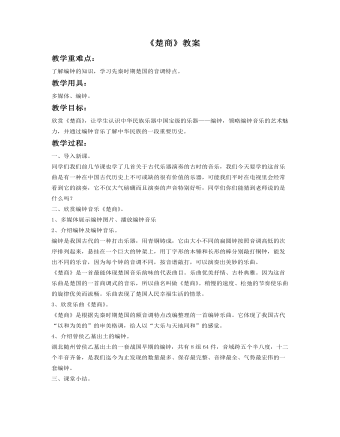
《楚商》教案
1、多媒体展示编钟图片、播放编钟音乐2、介绍编钟及编钟音乐。编钟是我国古代的一种打击乐器,用青铜铸成,它由大小不同的扁圆钟按照音调高低的次序排列起来,悬挂在一个巨大的钟架上,用丁字形的木锤和长形的棒分别敲打铜钟,能发出不同的乐音,因为每个钟的音调不同,按音谱敲打,可以演奏出美妙的乐曲。《楚商》是一首最能体现楚国音乐韵味的代表曲目。乐曲优美抒情、古朴典雅。因为这首乐曲是楚国的一首商调式的音乐,所以曲名叫做《楚商》。稍慢的速度、松弛的节奏使乐曲的旋律优美而流畅。乐曲表现了楚国人民幸福生活的情景。
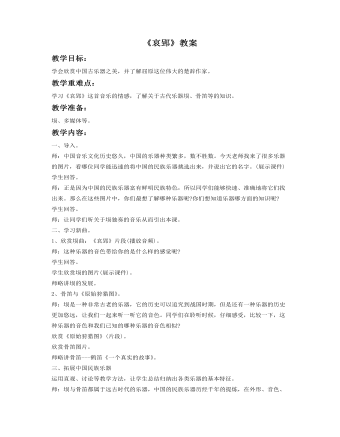
《哀郢》教案
教学内容:一、导入。师:中国音乐文化历史悠久,中国的乐器种类繁多,数不胜数。今天老师找来了很多乐器的图片,看哪位同学能迅速的将中国的民族乐器挑选出来,并说出它的名字。(展示课件)学生回答。师:正是因为中国的民族乐器富有鲜明民族特色,所以同学们能够快速、准确地将它们找出来。那么在这些图片中,你们最想了解哪种乐器呢?你们想知道乐器哪方面的知识呢?学生回答。师:让同学们听关于埙独奏的音乐从而引出本课。二、学习新曲。1、欣赏埙曲:《哀郢》片段(播放音频)。师:这种乐器的音色带给你的是什么样的感觉呢?学生回答。学生欣赏埙的图片(展示课件)。师略讲埙的发展。2、骨笛与《原始狩猎图》。师:埙是一种非常古老的乐器,它的历史可以追究到战国时期,但是还有一种乐器的历史更加悠远,让我们一起来听一听它的音色。同学们在聆听时候,仔细感受,比较一下,这种乐器的音色和我们已知的哪种乐器的音色相似?
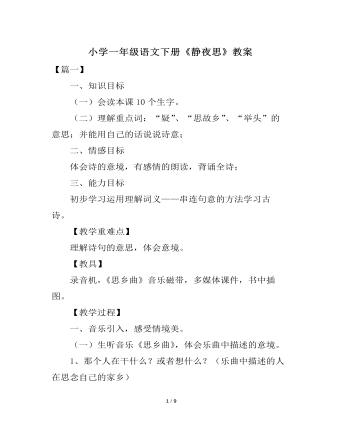
《静夜思》教案
(1)读整行诗。 (2)根据学生提出的问题理解“疑”的意思(怀疑、好像); “霜”(老师哈气在眼镜片上,并解释这是雾水,如果是冰粒,便是霜。霜在秋冬季节形成在地面附近:如房顶、草叶、地面等,堆起来是白色。) (3)说说这两行诗的意思。用上“什么好像是什么”的句式。(明亮的月光照在诗人的床前,好象是铺在地上的白白的霜) (4)朗读,引导。 诗人这样描写,给了你一种什么样的感觉?(冷清) 师描述:今晚,银白色的月光洒在地上,像铺了一层冰冷的霜一样。环境如此冷清,再加上诗人远离亲人的孤独,就更感到冷清了。
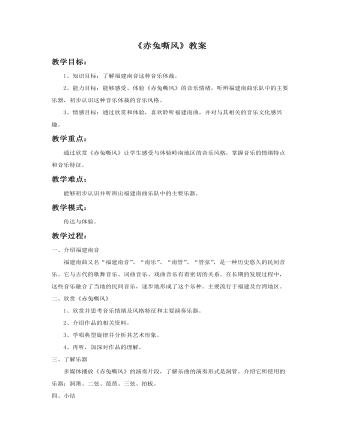
《赤兔嘶风》教案
一、介绍福建南音福建南曲又名“福建南音”、“南乐”、“南管”、“管弦”,是一种历史悠久的民间音乐。它与古代的歌舞音乐、词曲音乐、戏曲音乐有着密切的关系。在长期的发展过程中,这些音乐融合了当地的民间音乐,逐步地形成了这个乐种。主要流行于福建及台湾地区。二、欣赏《赤兔嘶风》1、欣赏并思考音乐情绪及风格特征和主要演奏乐器。2、介绍作品的相关资料。3、学唱典型旋律并分析其艺术形象。4、再听,加深对作品的理解。三、了解乐器多媒体播放《赤兔嘶风》的演奏片段,了解乐曲的演奏形式是洞管。介绍它所使用的乐器:洞箫、二弦、琵琶、三弦、拍板。
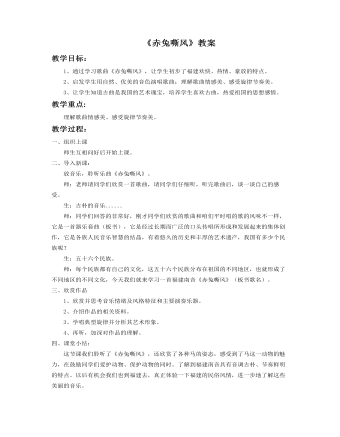
《赤兔嘶风》教案
教学目标:1、通过学习歌曲《赤兔嘶风》,让学生初步了福建欢快、热情、豪放的特点。2、启发学生用自然、优美的音色演唱歌曲;理解歌曲情感美、感受旋律节奏美。3、让学生知道古曲是我国的艺术瑰宝,培养学生喜欢古曲,热爱祖国的思想感情。这节课我们聆听了《赤兔嘶风》,还欣赏了各种马的姿态,感受到了马这一动物的魅力,在鼓励同学们爱护动物、保护动物的同时。了解到福建南音具有音调古朴、节奏鲜明的特点。以后有机会我们也到福建去,真正体验一下福建的民俗风情,进一步地了解这些美丽的音乐。
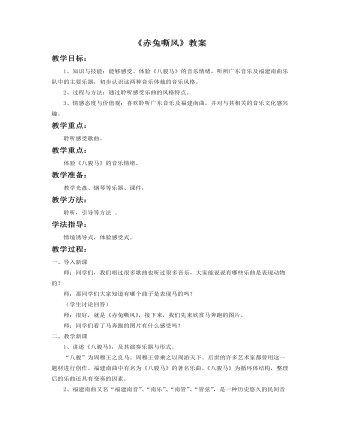
《赤兔嘶风》教案
一、导入新课师:同学们,我们唱过很多歌曲也听过很多音乐,大家能说说有哪些乐曲是表现动物的?师:那同学们大家知道有哪个曲子是表现马的吗?(学生讨论回答)师:很好,就是《赤兔嘶风》,接下来,我们先来欣赏马奔跑的图片。师:同学们看了马奔跑的图片有什么感受吗?二、教学新课1、讲述《八骏马》,及其演奏乐器与形式。 “八骏”为周穆王之良马。周穆王曾乘之以周游天下。后世的许多艺术家都曾用这一题材进行创作。福建南曲中有名为《八骏马》的著名乐曲。《八骏马》为循环体结构,整理后的乐曲还具有变奏的因素。2、福建南曲又名“福建南音”、“南乐”、“南管”、“管弦”,是一种历史悠久的民间音乐。它与古代的歌舞音乐、词曲音乐、戏曲音乐有着密切的关系。在长期的发展过程中,这些音乐融合了当地的民间音乐,逐步地形成了这个乐种。南曲包括了“指”、“谱”、“曲”三大部分。“指”是一种套曲;“谱”是有标题的器乐套曲;“曲”是有唱词的散曲,只唱不说。南曲的演奏形式有“上四管”、“下四管”之分。上四管以洞箫为主,叫做“洞管”;以笛子为主的叫做“品管”。
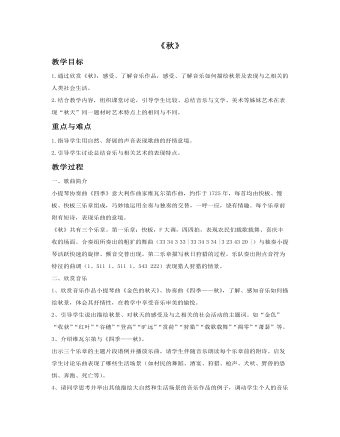
《秋》教案
欣赏音乐1、欣赏音乐作品小提琴曲《金色的秋天》、协奏曲《四季——秋》,了解、感知音乐如何描绘秋景,体会其抒情性,在教学中享受音乐审美的愉悦。2、引导学生说出描绘秋景、对秋天的感受及与之相关的社会活动的主题词。如“金色”“收获”“红叶”“谷穗”“登高”“旷远”“赏荷”“狩猎”“载歌载舞”“凋零”“萧瑟”等。3、介绍维瓦尔第与《四季——秋》。出示三个乐章的主题片段谱例并播放乐曲,请学生伴随音乐朗读每个乐章前的附诗。启发学生讨论乐曲表现了哪些生活场景(如村民的舞蹈、酒宴、狩猎、枪声、犬吠、野兽的恐惧、奔跑、死亡等)。4、请同学思考并举出其他描绘大自然和生活场景的音乐作品的例子,调动学生个人的音乐经验,引发其对于音乐具有描绘性功能的认识和兴趣。
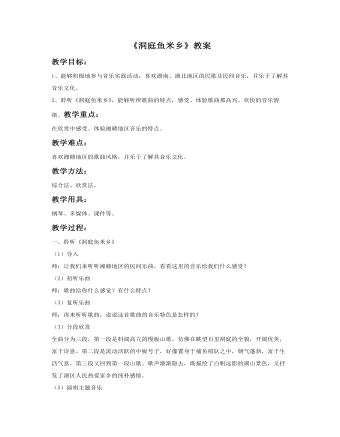
《洞庭鱼米乡》教案
一、聆听《洞庭鱼米乡》 (1)导入 师:让我们来听听湘赣地区的民间乐曲,看看这里的音乐给我们什么感受? (2)初听乐曲 师:歌曲给你什么感觉?有什么特点? (3)复听乐曲 师:再来听听歌曲,说说这首歌曲的音乐特色是怎样的?(3)分段欣赏全曲分为三段,第一段是料阔高亢的慢板山歌,仿佛在眺望百里洞庭的全貌,开阔优美,富于诗意。第二段是流动活跃的中板号子,好像置身于捕鱼船队之中,朝气蓬勃,富于生活气息。第三段又回到第一段山歌。歌声渐渐隐去,既描绘了白帆远影的湖山景色,又抒发了湖区人民热爱家乡的纯朴感情。(5)演唱主题音乐
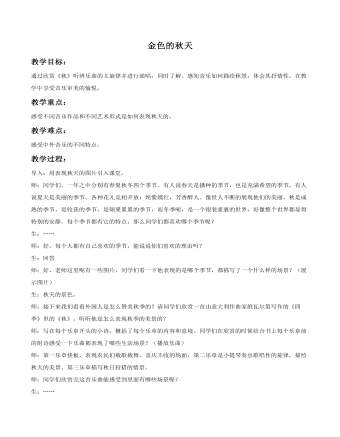
《秋》教案
导入:用表现秋天的图片引入课堂。师:同学们,一年之中分别有春夏秋冬四个季节。有人说春天是播种的季节,也是充满希望的季节,有人说夏天是美丽的季节。各种花儿竞相开放:姹紫嫣红,芳香醉人。像世人不断的展现他们的美丽,秋是成熟的季节,是收获的季节,是硕果累累的季节,而冬季呢,是一个银装素裹的世界,好像整个世界都显得特别的安静。每个季节都有它的特点,那么同学们都喜欢哪个季节呢?生:……师:好,每个人都有自己喜欢的季节,能说说你们喜欢的理由吗?生:回答师:好,老师这里呢有一些图片,同学们看一下他表现的是哪个季节,都描写了一个什么样的场景?(展示图片)生:秋天的景色。师:接下来我们看看外国人是怎么赞美秋季的?请同学们欣赏一首由意大利作曲家维瓦尔第写作的《四季》里的《秋》,听听他是怎么表现秋季的美景的?师:写在每个乐章开头的小诗,概括了每个乐章的内容和意境。同学们在欣赏的时候结合书上每个乐章前的附诗感受一下乐曲都表现了哪些生活场景?(播放乐曲)师:第一乐章快板,表现农民们载歌载舞、喜庆丰收的场面,第二乐章是小提琴奏出歌唱性的旋律,描绘秋天的美景。第三乐章描写秋日狩猎的情景。
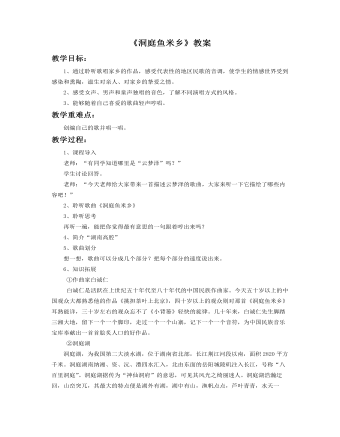
《洞庭鱼米乡》教案
知识拓展①作曲家白诚仁白诚仁是活跃在上世纪五十年代至八十年代的中国民族作曲家。今天五十岁以上的中国观众大都熟悉他的作品《挑担茶叶上北京》,四十岁以上的观众则对那首《洞庭鱼米乡》耳熟能详,三十岁左右的观众忘不了《小背篓》轻快的旋律。几十年来,白诚仁先生脚踏三湘大地,留下一个一个脚印,走过一个一个山寨,记下一个一个音符,为中国民族音乐宝库奉献出一首首脍炙人口的好作品。 ②洞庭湖洞庭湖,为我国第二大淡水湖,位于湖南省北部,长江荆江河段以南,面积2820平方千米。洞庭湖南纳湘、资、沅、澧四水汇入,北由东面的岳阳城陵矶注入长江,号称“八百里洞庭”。洞庭湖据传为“神仙洞府”的意思,可见其风光之绮丽迷人。洞庭湖浩瀚迂回,山峦突兀,其最大的特点便是湖外有湖,湖中有山,渔帆点点,芦叶青青,水天一色。
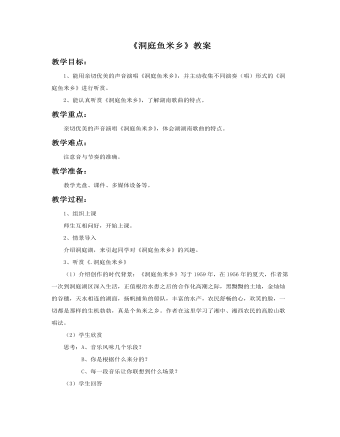
《洞庭鱼米乡》教案
教学过程:1、组织上课师生互相问好,开始上课。2、情景导入介绍洞庭湖,来引起同学对《洞庭鱼米乡》的兴趣。3、听赏《.洞庭鱼米乡》(1)介绍创作的时代背景:《洞庭鱼米乡》写于1959年,在1956年的夏天,作者第一次到洞庭湖区深入生活,正值根治水患之后的合作化高潮之际,黑黝黝的土地,金灿灿的谷穗,天水相连的湖面,扬帆捕鱼的船队,丰富的水产,农民舒畅的心,欢笑的脸,一切都是那样的生机勃勃,真是个鱼米之乡。作者在这里学习了湘中、湘西农民的高腔山歌唱法。(2)学生欣赏思考:A、音乐风味几个乐段?B、你是根据什么来分的?C、每一段音乐让你联想到什么场景?(3)学生回答

《曼德》教案
一、导入引导学生观看电影中的歌舞片段。导入对印度音乐文化的介绍。二、新课学习1. 印度的歌舞。教师:从影片中我们感受到印度的歌、乐、舞融合得非常紧密。所以,我们先来了解一下印度的歌舞。(1)介绍印度的舞蹈分为:古典舞、民族舞和流行歌舞。而以宝莱坞为代表的印度电影音乐,多为流行歌舞的范畴。而印度最具代表性的舞蹈当属古典舞。(2)观察印度古典舞的九种面部表情。请学生尝试分辨出哪一个是“爱”的表情。学生选择后(答案为左上第一幅图),教师小结:由于文化的不同,不同国家的人们对包括表情在内的许多事物会有不同的含义与理解。(3)请学生随录像(最好由教师亲自示范录像中: “身体健康、万事如意!”这一句),请学生模仿手语,传达相互的问候。





















